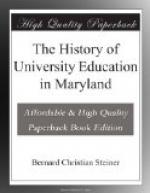As soon as the building was under roof, a preparatory school was opened and the Trustees applied to John Wesley for a President. He suggested a Rev. Mr. Heath, and this suggestion was accepted on December 23, 1786.[31] His inauguration occurred a year later and was a grand affair. Asbury presided on each of the three days of the ceremony, and his text on the second day, “O man of God, there is death in the pot,"[32] was looked on by the superstitious, in time to come, as a presage of disaster. The faculty was filled up and all seemed to bid fair for prosperity; but Mr. Heath remained in charge of the College less than a year, resigning because of certain charges of insufficiency, which seem rather trival. Another professor left to go into business and Asbury’s soul was tried by these “heavy tidings.”
The good Bishop was indefatigable in his care of Cokesbury. His visits were frequent, and while there, he was very active, examining the pupils, preaching, and arranging the affairs, both temporal and spiritual. Abingdon became a centre of Methodism, families moved there to enjoy the educational advantages, and the Conference regularly visited the College, coming over from Baltimore for that purpose.
Dr. Jacob Hall, of Abingdon, was the second President, and had under him a faculty of three professors and a chaplain. The school prospered and had public exhibitions of its students’ proficiency from time to time. It is doubtful if sufficient care was exercised in the expenditure of money and, in December, 1790, the Trustees felt obliged to contract a loan of L1000. The charitable contributions fell off, and Asbury was forced to go from house to house in Baltimore, “through the snow and cold, begging money for the support of the poor orphans at Cokesbury."[33] The instruction was good, and Asbury could write to Coke, then in England, that “one promising young man has gone forth into the ministry, another is ready, and several have been under awakenings. None so healthy and orderly as our children, and some promise great talents for learning."[34] Still, “all was not well there,” and on October 2, 1793, he “found matters in a poor state at college; L500 in debt, and our employes L700 in arrears.” A year later, matters were desperate and the good Bishop wrote that “we now make a sudden and dead pause—we mean to incorporate and breathe and take some better plan. If we can not have a Christian school (i.e. a school under Christian discipline and pious teachers), we will have none."[35] The project of incorporation was not favored by some, who feared that the College would not be thereby so directly under the control of the Conference, but was carried through, and the charter bears date, December 26, 1794.[36] By it, the institution was allowed to have an income not exceeding L3,000.
How a charter was to avoid increased indebtedness does not appear and the College’s debt had so increased, that the Conference in 1795 decided to suspend the Collegiate Department and have only an English Free School kept in the buildings.[37]




